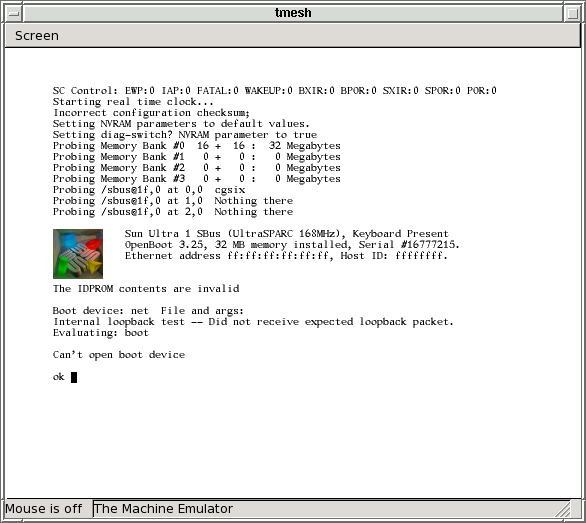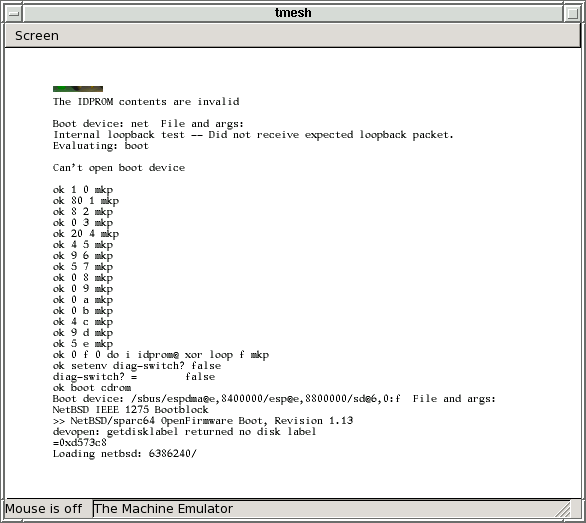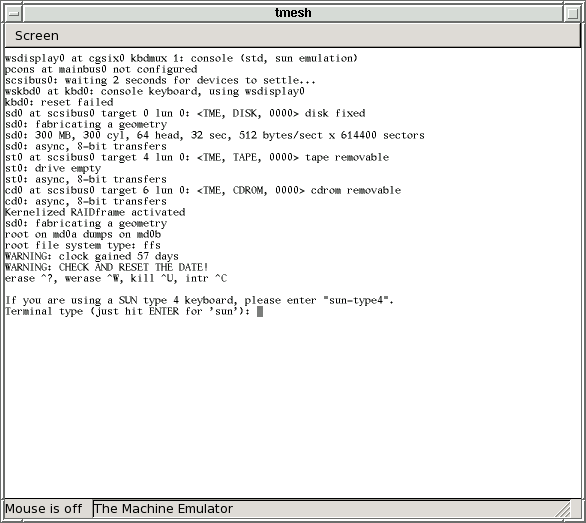Booting and using the NetBSD install CD-ROM
Once you have an installation CD-ROM image, you must boot it.
-
Start the emulator. Remember, if you're running a
statically-linked, uninstalled emulator, you must have the environment
variable LTDL_LIBRARY_PATH set to the top of your build
tree:
% cd /some/where/my-sun4u
% tmesh ./MY-SUN4U
ignore any cannot generate keysym warnings tmesh>The emulator itself is called tmesh. tmesh is a shell for running commands that create and control emulated machines. One day, you will be able to create and manage a whole set of emulated machines running inside the same tmesh process, but for now it's only been tested to handle one machine.
tmesh takes one argument on its command line: the name of a text file containing initial commands for it to execute. In this case, MY-SUN4U contains commands to assemble a Sun Ultra 1.
A new blank GTK window should appear on your screen. If you see any error messages, hopefully they're descriptive enough to help you figure out what went wrong. Usually, the first error listed is the real problem; when a central element of the emulated Sun Ultra 1 can't be created, many subsequent errors will be generated because all of the attachments to that central element also fail.
If you don't see any error messages, at this tmesh> prompt, give the ls command. This should give the following output:
tmesh> ls sc0: tme/ic/stp2200 cpu0 at sc0 addr 0x1c000000000: tme/ic/stp1030 tick-frequency 167M fpu-type builtin fpu-compliance partial fpu-incomplete trap sbus0 at sc0 addr 0x1fe00000000: tme/ic/stp2220 ram0 at sc0 addr 0x00000000: tme/host/posix/memory ram 32MB flash0 at sbus0 slot 15 offset 0x0000000: tme/host/posix/memory rom SUNW,501-3082-update7.bin zs0 at sbus0 slot 15 offset 0x1100000: tme/ic/ncr89c105/z85c30 zs1 at sbus0 slot 15 offset 0x1000000: tme/ic/ncr89c105/z85c30 nvram0 at sbus0 slot 15 offset 0x1200000: tme/host/posix/memory persistent my-sun4u-nvram.bin clock0 at sbus0 slot 15 offset 0x1201ff0: tme/machine/sun4/clock type tme/ic/mk48t59 fdtwo0 at sbus0 slot 15 offset 0x1400000: tme/ic/ncr89c105/i82077 auxio0 at sbus0 slot 15 offset 0x1900000: tme/ic/ncr89c105/auxio apcdma0 at sbus0 slot 13 offset 0x0: tme/ic/stp2024 id 0x3 audiocs0 at apcdma0 codec: tme/ic/cs4231A kbd0 at zs1 channel A: tme/serial/keyboard type sun-type-4-us macros my-sun-macros.txt map sun-keyboards.txt rate 20 ms0 at zs1 channel B: tme/serial/mouse type mousesystems-5 console0 at zs0 channel A: tme/host/posix/serial device /dev/ttyr0 break-carats esp0 at sbus0 slot 14 offset 0x8800000: tme/ic/lsi64854 revision 1+ channel scsi esp0 dma at sbus0 slot 14 offset 0x8400000 ncr0 at esp0 master: tme/ic/ncr53c9x variant esp100 scsibus0 at ncr0: tme/scsi/bus ledma0 dma at sbus0 slot 14 offset 0x8400010: tme/ic/lsi64854 revision 2 channel ethernet ledma0 at sbus0 slot 14 offset 0x8c00000 le0 at ledma0 master: tme/ic/am7990 bpp0 at sbus0 slot 14 offset 0xc800000: tme/ic/lsi64854 revision 1+ channel parallel cgsix0 at sbus0 slot 0 offset 0x0: tme/bus/sbus/cgsix type 501-2325 cgsixrom0 at sbus0 slot 0 offset 0x0: tme/host/posix/memory rom SUNW,501-2325.bin display0 at cgsix0: tme/host/gtk/display display0 at kbd0 display0 at ms0 sd0 at scsibus0: tme/scsi/disk id 0 type tme-scsi-1 disk0 at sd0: tme/host/posix/disk file my-sun4u-disk.img st0 at scsibus0: tme/scsi/tape id 4 type tme-scsi-1 tape0 at st0: tme/host/posix/tape
If the output contains all of these entries, your emulated Sun Ultra 1 is ready to run.
-
The next step is to load the install CD-ROM image into the CD-ROM drive:
WARNING: Unfortunately, the current release of tme doesn't have true CD-ROM emulation. Temporarily, the modules that emulate regular disks are being reused to create a minimal CD-ROM emulation.
What this means is that the CD-ROM emulation isn't very useful except for installation. For this reason, the CD-ROM emulation isn't enabled by default in the configuration file, and you have to give these long commands here to enable it:
tmesh> cd0 at scsibus0: tme/scsi/cdrom id 6 type tme-scsi-1 tmesh> cdrom0 at cd0: tme/host/posix/disk file sparc64cd-5.0.1.iso read-only
-
Now you should be able to power up the emulated Sun Ultra 1:
tmesh> command sc0 power
After a while (the Sun Ultra 1 PROM includes some unfortunate delays), you should see something like this:
Because you started out with an NVRAM full of zeroes, the PROM set the diag-switch? parameter to true and tried to boot off of the network, which (assuming that you haven't enabled tme to access and boot off of the network yet) failed.
Before installing NetBSD, it's best to set the IDPROM information in the NVRAM. The following procedure is derived from the Sun NVRAM/hostid FAQ.
First, you must choose an Ethernet address for your emulator - even if tme won't have access to the network. Ethernet addresses for Sun workstations always begin with 8:0:20, so pick three hexadecimal bytes XX:YY:ZZ such that 8:0:20:XX:YY:ZZ is not taken by any other machine on your LAN.
Next, set the IDPROM information with these OpenBoot commands, substituting for the XX, YY and ZZ (note that there are two of each):
ok 1 0 mkp ok 80 1 mkp ok 8 2 mkp ok 0 3 mkp ok 20 4 mkp ok XX 5 mkp ok YY 6 mkp ok ZZ 7 mkp ok 0 8 mkp ok 0 9 mkp ok 0 a mkp ok 0 b mkp ok XX c mkp ok YY d mkp ok ZZ e mkp ok 0 f 0 do i idprom@ xor loop f mkp
Now you can turn the diagnostics switch off:ok setenv diag-switch? false diag-switch? = false ok
Now, tell the PROM to boot the install CD-ROM:ok boot cdrom
After a short delay, the PROM should begin booting the install CD-ROM image:
Once the INSTALL kernel has been booted, the installation RAM disk will display the first prompt:

You do want to enter sun-type4, since tme emulates a Sun type-4 keyboard. After that, sysinst will start.